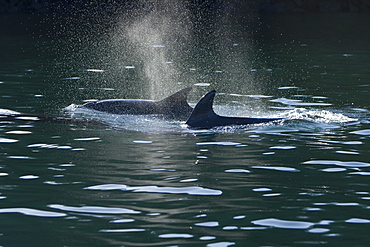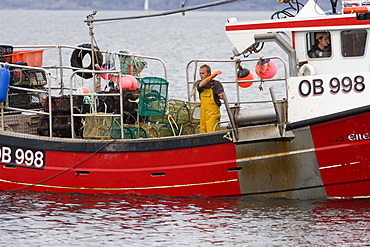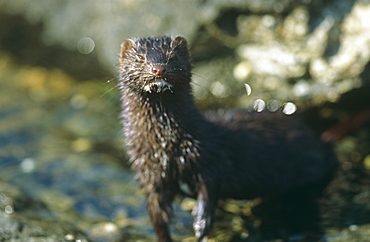Recent searches
Loading...
988-66 - Eurasian river otter (Lutra lutra) mother eating fish with cub closeby. The cub tried unsuccessfully to obtain some of its mother's catch. Hebrides, Scotland
988-6 - Bottlenose dolphin (Tursiops truncatus). Hebrides, Scotland
988-198 - Freshwater loch. Black Mount by Rannoch Moor near Glencoe, Scotland.
988-108 - Eurasian river otter (Lutra lutra) eating fish. Otters have adapted well to the marine environment but require sources of fresh water to drink and to clean fur. Hebrides, Scotland
988-167 - Land-based cetacean survey. Cetacean survey work by personnel of the Hebridean Whale and Dolphin Trust. Caliach Point, Isle of Mull, Scotland
988-169 - Harbour porpoise (Phocoena phocoena) caught in herring weir (fish trap). Porpoises trapped in herring weirs often die as a result of efforts to remove them (by 'seining' the weir as shown here) but latterly cooperation between fishermen and researchers has improved the situation. Five porpoises were trapped in this weir and none were thought to have survived this operation. Grand Manan, Bay of Fundy, Canada
988-76 - Eurasian river otter (Lutra lutra). Hebrides, Scotland.
988-155 - Skein of geese. The classic 'V' shape of a skein of migrating geese. Hebrides, Scotland
988-60 - Eurasian river otter (Lutra lutra) eating a large crab. Large fish and crabs are difficult to constrain and eat in the water so are often brought ashore. Otters will sometimes swim realtively long distances in order to do so. Hebrides, Scotland
988-145 - Shag (Phalacrocorax aristotelis) on old pier. Shags use the old pier at Salen. Isle of Mull, throughout the year from which to forage in the Sound of Mull. Hebrides, Scotland
988-158 - Common Sandpiper (Actitis hypoleucos) on rocky marine foreshore. Hebrides, Scotland.
988-119 - Brown hawker dragonfly (Aeshna grandis). Staffordshire, England
988-114 - American mink (Mustela vison). Non-native species in the UK considered a threat to ground-nesting birds and water voles in particular. Widespread as a result of escapes from fur farms since the 1950s. Hebrides, Scotland
988-225 - Bottlenose dolphins (Tursiops truncatus) in Tobermory Bay - home of Balamory TV show. This group of dolphins are resident in the Hebrides but are hard to find and not well understood. They rarely come into the this harbour but photographer Nic Davies was ready with his camera and kayak to get these great, low angle shots.
988-102 - Eurasian river otter (Lutra lutra) eating flatfish. Hebrides, Scotland
988-39 - Pair of Eurasian river otters (Lutra lutra) foraging in and among the seaweed. Otters on Scotland's west coast and islands have adapted well to making a living in the marine environment. Hebrides, Scotland
988-62 - Eurasian river otter (Lutra lutra) resting on seaweed. Otters spend a great deal of time resting ashore, usually near to the water's edge. This time is spent sleeping and preening fur etc. Visits ashore may also be to find fresh water to drink. Hebrides, Scotland
988-55 - Eurasian river otter (Lutra lutra) resting on seaweed. Otters spend a great deal of time resting ashore, usually near to the water's edge. This time is spent sleeping and preening fur etc. Visits ashore may also be to find fresh water to drink. Hebrides, Scotland
988-152 - Mute swan (Cygnus olor) at sea. Most people might associate swans with a freshwater environment but they can also be seen in a marine setting. Hebrides, Scotland
988-26 - Eurasian river otter (Lutra lutra). Hebrides, Scotland
988-83 - Eurasian river otter (Lutra lutra) eating a large crab. Large fish and crabs are difficult to constrain and eat in the water so are often brought ashore. Otters will sometimes swim realtively long distances in order to do so. Hebrides, Scotland
988-12 - Common Bottlenose Dolphin (Tursiops truncatus truncatus). Hebrides, UK.
988-121 - Wild iris (). Unlike variants grown outwith the wild, reportedly all wild irises are yellow in colour. Hebrides, Scotland.
988-221 - Sun setting behind the Burg Wilderness on Mull (at left), an area owned and conserved by the National Trust for Scotland. Hebrides, Scotland
988-135 - Guillemot (Uria aalge) and razorbill (Alca torda) colonies on Harp Rock, Lunga. Hebrides, Scotland
988-103 - Eurasian river otter (Lutra lutra) eating fish. Hebrides, Scotland
988-43 - Eurasian river otter (Lutra lutra) foraging in and among the seaweed. Otters on Scotland's west coast and islands have adapted well to making a living in the marine environment. Hebrides, Scotland
988-172 - Salmon in fish farm. Salmon jumping in fish farm, behaviour thought to be associated with dislodging lice. Hebrides, Scotland
988-159 - Common Sandpiper (Actitis hypoleucos) on rocky marine foreshore. Hebrides, Scotland.
988-7 - Common Bottlenose Dolphin (Tursiops truncatus truncatus). Hebrides, UK.
988-161 - Common Sandpiper (Actitis hypoleucos) on rocky marine foreshore. Hebrides, Scotland.
988-237 - Bottlenose dolphins (Tursiops truncatus) in Tobermory Bay - home of Balamory TV show. This group of dolphins are resident in the Hebrides but are hard to find and not well understood. They rarely come into the this harbour but photographer Nic Davies was ready with his camera and kayak to get these great, low angle shots.
988-132 - Guillemot (Uria aalge) colony with chicks ready to leave to sea. Hebrides, Scotland
988-74 - Eurasian river otter (Lutra lutra). Hebrides, Scotland.
988-79 - Eurasian river otter (Lutra lutra) resting in the seaweed and rocks. Otters spend a great deal of time resting, usually close to the water's edge or on rocks just offshore. This time is spent sleeping and preening fur etc. Notice the recent injuries sustained by this otter around the head and neck area. Hebrides, Scotland
988-98 - Eurasian river otter (Lutra lutra). Otters in western Scotland have adapted well to life in a marine environment, though proximity to sources of fresh water is essential. Hebrides, Scotland
988-101 - Family of Eurasian river otters (Lutra lutra) sprainting on high point. The spraint is a method of marking territory and high points are a favoured location, even those washed by tides.
988-150 - Mute swan (Cygnus olor) at sea. Most people might associate swans with a freshwater environment but they can also be seen in a marine setting. Hebrides, Scotland
988-129 - Horned puffin (Fratercula arctica). Hebrides, Scotland
988-142 - Shag (Phalacrocorax aristotelis) on old pier. Shags use the old pier at Salen. Isle of Mull, throughout the year from which to forage in the Sound of Mull. Hebrides, Scotland
988-170 - Creel boat. 'Eilean Ban' shooting creels to catch lobster, crab etc. Hebrides, Scotland
988-44 - Eurasian river otter (Lutra lutra) finishing a meal in the seaweed. Hebrides, Scotland
988-11 - Common Bottlenose Dolphin (Tursiops truncatus truncatus). Hebrides, UK.
988-238 - Bottlenose dolphins (Tursiops truncatus) in Tobermory Bay - home of Balamory TV show. This group of dolphins are resident in the Hebrides but are hard to find and not well understood. They rarely come into the this harbour but photographer Nic Davies was ready with his camera and kayak to get these great, low angle shots.
988-171 - Creel boat. 'Eilean Ban' shooting creels to catch lobster, crab etc. Hebrides, Scotland
988-143 - Shag (Phalacrocorax aristotelis) on old pier. Shags use the old pier at Salen. Isle of Mull, throughout the year from which to forage in the Sound of Mull. Hebrides, Scotland
988-130 - Guillemot (Uria aalge), razorbill (Alca torda) and puffin (Fratercula arctica) nesting together. Space is at a premium on the nesting sites in the Treshnish Isles so different species have to get along with each other. Hebrides, Scotland
988-3 - Bottlenose dolphin (Tursiops truncatus). Hebrides, Scotland
988-31 - Eurasian river otter (Lutra lutra). Hebrides, Scotland
988-37 - Eurasian river otter (Lutra lutra). Hebrides, Scotland
988-126 - Horned puffin (Fratercula arctica). Hebrides, Scotland
988-23 - Minke whale (Balaenoptera acutorostrata). Damage to dorsal fins is often used for photo-identification purposes but even simply the shape of a 'clean' fin such as this may be identifiable. Hebrides, Scotland
988-153 - Mute swan (Cygnus olor) at sea. Most people might associate swans with a freshwater environment but they can also be seen in a marine setting. Hebrides, Scotland
988-207 - Entrance to Fingal's Cave, Staffa. Note the basalt columns which are not always six-sided. Hebrides, Scotland
988-104 - Eurasian river otter (Lutra lutra) sprainting on high point. The spraint is a method of marking territory and high points are a favoured location, even those washed by tides.
988-94 - Eurasian river otter (Lutra lutra). Otters in western Scotland have adapted well to life in a marine environment, though proximity to sources of fresh water is essential. Hebrides, Scotland
988-110 - American mink (Mustela vison). Non-native species in the UK considered a threat to ground-nesting birds and water voles in particular. Widespread as a result of escapes from fur farms since the 1950s. Hebrides, Scotland
988-122 - Horned puffin (Fratercula arctica). Hebrides, Scotland
988-49 - Eurasian river otter (Lutra lutra) resting in the seaweed and rocks. Otters spend a great deal of time resting, usually close to the water's edge or on rocks just offshore. This time is spent sleeping and preening fur etc. Notice the recent injuries sustained by this otter around the head and neck area. Hebrides, Scotland
988-208 - The 'Shepherd', Staffa. This basalt column rock formation sits close to the one safe landing spot on Staffa. Hebrides, Scotland
988-214 - Creel boat by Tobermory's multi-coloured Main Street. Hebrides, Scotland (RR)
988-149 - Mute swan (Cygnus olor) at sea, Ben Nevis in background. Most people might associate swans with a freshwater environment but they can also be seen in a marine setting. Hebrides, Scotland
988-17 - Common dolphin (Delphinus delphis). Hebrides, Scotland
988-33 - Eurasian river otter (Lutra lutra). Hebrides, Scotland
988-200 - Freshwater loch. Black Mount by Rannoch Moor near Glencoe, Scotland.
988-199 - Freshwater loch. Black Mount by Rannoch Moor near Glencoe, Scotland.
988-183 - Helicopter supplying salmon farm. Hebrides, UK.
988-41 - Eurasian river otter (Lutra lutra) foraging in and among the seaweed. Otters on Scotland's west coast and islands have adapted well to making a living in the marine environment. Hebrides, Scotland
988-96 - Eurasian river otter (Lutra lutra). Otters in western Scotland have adapted well to life in a marine environment, though proximity to sources of fresh water is essential. Hebrides, Scotland
988-95 - Eurasian river otter (Lutra lutra) eating fish. Hebrides, Scotland
988-128 - Horned puffin (Fratercula arctica). Hebrides, Scotland
988-1 - Bottlenose dolphins (Tursiops truncatus). Hebrides, Scotland
988-230 - Bottlenose dolphins (Tursiops truncatus) in Tobermory Bay - home of Balamory TV show. This group of dolphins are resident in the Hebrides but are hard to find and not well understood. They rarely come into the this harbour but photographer Nic Davies was ready with his camera and kayak to get these great, low angle shots.
988-85 - Eurasian river otter (Lutra lutra) eating Greater spotted dogfish (Scyliorhinus stellaris). The otter took only the innards of the dogfish by opening a short section of skin behind the pectoral fin (see images under 'Greater spotted dogfish'). The rest of the fish, still alive, was left on the shore and never retrieved. Perhaps the tough shark skin and battling fish are too much work when other food is plentiful? Hebrides, Scotland
988-47 - Eurasian river otter (Lutra lutra) resting in the seaweed and rocks. Otters spend a great deal of time resting, usually close to the water's edge or on rocks just offshore. This time is spent sleeping and preening fur etc. Notice the recent injuries sustained by this otter around the head and neck area. Hebrides, Scotland
988-168 - Minke whale (Balaenoptera acutorostrata) caught in creel line. Minke whales are occasionally caught in the lines connecting lobster pots (creels) and will drown if not released promptly. This creel fishermen helped researchers untangle this dead whale from another fisherman's gear. Hebrides, Scotland
988-89 - Eurasian river otter (Lutra lutra). Hebrides, Scotland.
988-84 - Eurasian river otter (Lutra lutra) resting on seaweed. Otters spend a great deal of time resting ashore, usually near to the water's edge. This time is spent sleeping and preening fur etc. Visits ashore may also be to find fresh water to drink. Hebrides, Scotland
988-123 - Horned puffin (Fratercula arctica). Mating behaviour by nesting burrow. Hebrides, Scotland (RR)
988-71 - Eurasian river otter (Lutra lutra) in the marine environment to which they have adapted so successfully. Hebrides, Scotland.
988-147 - Great skua (Stercorarius skua). Great skuas will often approach boats at sea in the hope of food and will kill other birds up to and including great black-backed gulls. Hebrides, Scotland
988-202 - Freshwater loch. Black Mount by Rannoch Moor near Glencoe, Scotland.
988-50 - Eurasian river otter (Lutra lutra) resting in the seaweed and rocks. Otters spend a great deal of time resting, usually close to the water's edge or on rocks just offshore. This time is spent sleeping and preening fur etc. Notice the recent injuries sustained by this otter around the head and neck area. Hebrides, Scotland
988-228 - Bottlenose dolphins (Tursiops truncatus) in Tobermory Bay - home of Balamory TV show. This group of dolphins are resident in the Hebrides but are hard to find and not well understood. They rarely come into the this harbour but photographer Nic Davies was ready with his camera and kayak to get these great, low angle shots.
988-243 - Bottlenose dolphins (Tursiops truncatus) in Tobermory Bay - home of Balamory TV show. This group of dolphins are resident in the Hebrides but are hard to find and not well understood. They rarely come into the this harbour but photographer Nic Davies was ready with his camera and kayak to get these great, low angle shots.
988-97 - Eurasian river otter (Lutra lutra) resting. Otters take regular breaks during their foraging activities, often choosing high points or islets just offshore in order to sleep, preen and play. Hebrides, Scotland
988-146 - Cormorant (Phalacrocorax carbo) on old pier. Cormorants use the old pier at Salen. Isle of Mull, to forage in the Sound of Mull. Hebrides, Scotland
988-234 - Bottlenose dolphins (Tursiops truncatus) in Tobermory Bay - home of Balamory TV show. This group of dolphins are resident in the Hebrides but are hard to find and not well understood. They rarely come into the this harbour but photographer Nic Davies was ready with his camera and kayak to get these great, low angle shots.
988-118 - Common hawker dragonfly (Aeshna juncea). Staffordshire, England (RR)
988-90 - Eurasian river otter (Lutra lutra) foraging in and among the seaweed. Otters on Scotland's west coast and islands have adapted well to making a living in the marine environment. Hebrides, Scotland (RR)
988-111 - American mink (Mustela vison). Non-native species in the UK considered a threat to ground-nesting birds and water voles in particular. Widespread as a result of escapes from fur farms since the 1950s. Hebrides, Scotland
988-8 - Common Bottlenose Dolphin (Tursiops truncatus truncatus). Hebrides, UK.



































































































